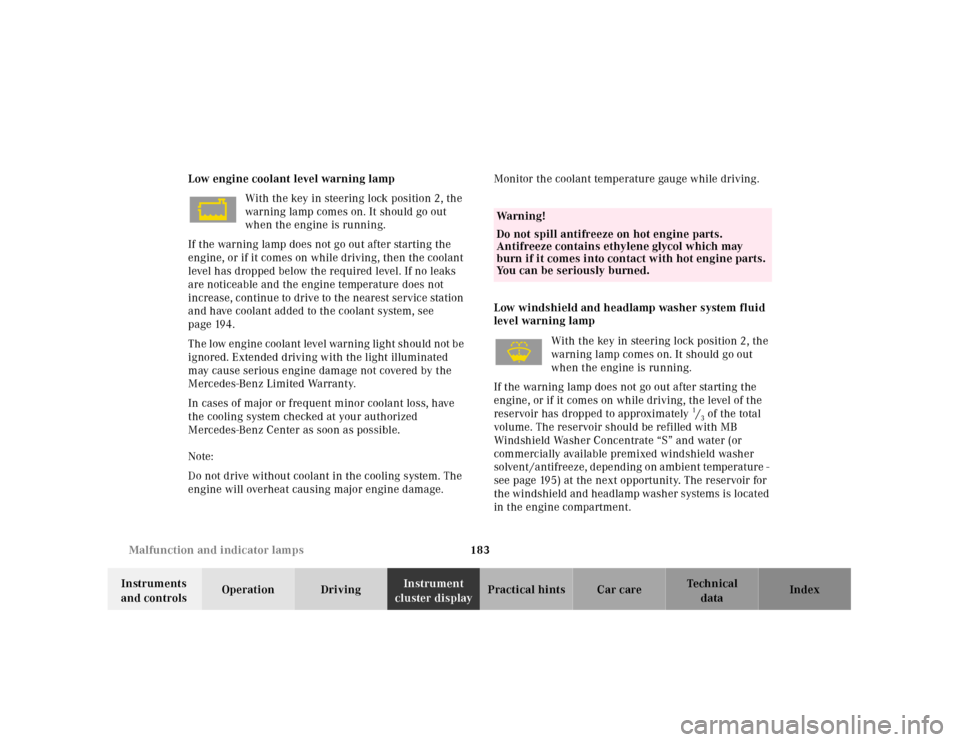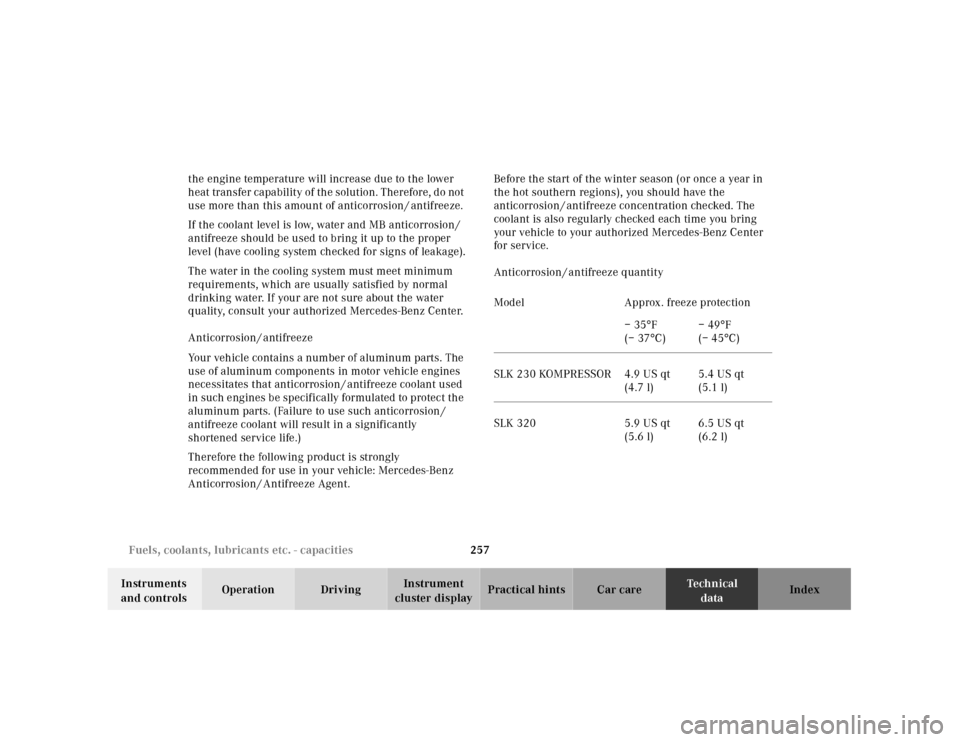coolant level MERCEDES-BENZ SLK320 2000 R170 Owner's Manual
[x] Cancel search | Manufacturer: MERCEDES-BENZ, Model Year: 2000, Model line: SLK320, Model: MERCEDES-BENZ SLK320 2000 R170Pages: 273
Page 6 of 273

3 Contents
Instrument cluster displayMalfunction and indicator
lamps in the instrument
cluster ......................................... 178
On-board diagnostic system ..... 178
Check engine malfunction
indicator lamp ............................. 178
Brake warning lamp .................. 179
Brake pad wear
indicator lamp ............................. 180
Seat belt nonusage
warning lamp .............................. 180
Supplemental restraint
system (SRS)
indicator lamp ............................. 180
Fuel reserve and fuel cap
placement warning .................... 181
Electronic stability
program (ESP) —
warning lamp .............................. 181
BAS / ESP malfunction
indicator lamp ............................. 181
ABS malfunction
indicator lamp ............................. 182Telescoping steering
column warning lamp ................182
Low engine coolant level
warning lamp ..............................183
Low windshield and
headlamp washer system
f luid level warning lamp ...........183
Low engine oil level
warning lamp ..............................184
Charge indicator lamp ...............184
Exterior lamp failure
indicator lamp .............................185
Additional function
indicator lamps
(in the odometer display) ..........185
Malfunction and indicator
lamp in the center console .......185
AIRBAG OFF
indicator lamp .............................185
Practical hintsFirst aid kit ......................................188
Stowing things
in the vehicle .............................188Fuses ................................................ 188
Hood ................................................. 190
Automatic transmission
fluid level ................................... 192
Checking engine oil level ............. 193
Coolant level ................................... 194
Adding coolant ........................... 194
Windshield and
headlamp washer system ........ 195
Air pump, spare wheel,
vehicle tools,
storage compartment ................ 196
Vehicle jack ..................................... 197
Wheels ............................................. 198
Tire replacement ........................ 198
Rotating wheels .......................... 199
Spare wheel ....................................200
Spare wheel bolts ....................... 201
Changing wheels ...........................202
Inflating the collapsible
spare tire .....................................207
Storing spare wheel in
wheel well ...................................208
Tire inflation pressure ..................209
Page 73 of 273

70 Instrument cluster
Te ch n ica l
data Instruments
and controlsOperationDrivingInstrument
cluster displayPractical hints Car care Index
Indicator lamps in the instrument cluster
High beam
ABS malfunction, see page 182
Brake fluid low (except Canada).
Parking brake engaged, see page 179
Brake fluid low (Canada only).
Parking brake engaged, see page 179
BAS malfunction, see page 181
ESP malfunction, see page 181
ESP. Adjust driving to road condition,
see page 181
Fasten seat belts, see page 180
Fluid level for windshield and headlamp
washer system low, see page 183
Coolant level low, see page 183
Engine oil level low, see page 184Brake pads worn down, see page 180
Battery not being charged properly,
see page 184
Exterior lamp failure, see page 185
Telescoping steering column not locked,
see page 182
SRS malfunction, see page 180
Engine malfunction indicator lamp. If the
malfunction indicator lamp comes on when
the engine is running, it indicates a
malfunction of the fuel management system,
emission control system, systems which
impact emissions, or the fuel cap is not
c l o se d t i g h t. I n a l l c a se s, w e r e c o m m e n d t h a t
you have the malfunction checked as soon as
possible, see page 178
Function indicator lamp on the center console
Front passenger airbag automatically
switched off, see page 185
ABS
AIRBAGOFF
Page 178 of 273

175 What you should know at the gas station
Te ch n ica l
data Instruments
and controlsOperationDrivingInstrument
cluster displayPractical hints Car care Index Engine oil
Engine oil level check, see page 193.
Fil l qua ntity between u pper a nd l owe r dipstick ma rking
level: 2.1 US qt (2.0 l).
Recommended engine oils, see Approved Service
Products sheet.
Coolant
For normal replenishing, use water (potable water
quality).
For further information (e.g. anticorrosion / antifreeze),
see page 256.
Spark plugs
Approved spark plugs, see page 251.
Tire pressure
For tire pressure, refer to tire pressure label inside the
fuel filler flap.Air conditioner
R-134a refrigerant and special PAG lubricant, see
page 252.
Bulbs
High and low beams (Halogen): H7 (55 W),
fog lamps: H1 (55 W),
turn signal lamps, parking and standing lamps, front:
2357 NA (28.5 / 8.3 W / 30 / 2.2 cp),
side marker lamps, front: 5 W / 4 cp
stop lamps: 1154 21 W / 32 cp,
backup lamps: 1154 21 W / 32 cp,
turn signal lamps, rear: 1156 NA 21 W / 24cp,
tail, parking and standing lamps: 67 5 W / 4cp,
rear fog lamp, driver´s side: 1155 21 W / 32 cp,
license plate lamps: 67 5 W / 4 cp
Xenon bulb for low beam: D2R (35W)
Wa r n i n g !
Because of high voltage in Xenon lamps, it is
dangerous to replace the bulb or repair the lamp
and its components. We recommend that you have
such work done by a qualified technician.
Page 179 of 273

176 Check regularly and before a long trip
Te ch n ica l
data Instruments
and controlsOperationDrivingInstrument
cluster displayPractical hints Car care Index
Check regularly and before a long trip
SLK 230 Kompressor shown1Windshield washer and
headlamp cleaning system
For refilling reservoir, see page 195.
2Coolant level
See “Adding coolant” on page 194.
3Engine oil level
See “Checking engine oil level” on page 193 and
“Engine oil level indicator” on page 77.
4Brake fluid
See “Brake fluid” on page 254.
Opening hood, see page 190.
Ve h i c l e l i g h t i n g : Check function and cleanliness. For
replacement of light bulbs, see “Exterior lamps” on
page 218.
Exterior lamp switch, see page 79.
Page 180 of 273

177 Contents - Instrument cluster display
Te ch n ica l
data Instruments
and controlsOperation DrivingInstrument
cluster displayPractical hints Car care Index
Instrument cluster displayMalfunction and indicator
lamps in the instrument
cluster ......................................... 178
On-board
diagnostic system ....................... 178
Check engine malfunction
indicator lamp ............................. 178
Brake warning lamp .................. 179
Brake pad wear
indicator lamp ............................. 180
Seat belt nonusage
warning lamp .............................. 180Supplemental restraint system
(SRS) indicator lamp ..................180
Fuel reserve and fuel cap
placement warning .................... 181
Electronic stability program
(ESP) — warning lamp ................181
BAS / ESP malfunction
indicator lamp ............................. 181
ABS malfunction
indicator lamp .............................182
Telescoping steering
column warning lamp ................182
Low engine coolant level
warning lamp ..............................183Low windshield and
headlamp washer system
fluid level warning lamp ........... 183
Low engine oil level
warning lamp .............................. 184
Charge indicator lamp ............... 184
Exterior lamp failure
indicator lamp ............................. 185
Additional function
indicator lamps
(in the odometer display) .......... 185
Malfunction and indicator
lamp in the
center console ........................... 185
AIRBAG OFF indicator lamp ..... 185
Page 186 of 273

183 Malfunction and indicator lamps
Te ch n ica l
data Instruments
and controlsOperation DrivingInstrument
cluster displayPractical hints Car care Index Low engine coolant level warning lamp
With the key in steering lock position 2, the
warning lamp comes on. It should go out
when the engine is running.
If the warning lamp does not go out after starting the
engine, or if it comes on while driving, then the coolant
level has dropped below the required level. If no leaks
are noticeable and the engine temperature does not
increase, continue to drive to the nearest service station
and have coolant added to the coolant system, see
page 194.
The low engine coolant level warning light should not be
ignored. Extended driving with the light illuminated
may cause serious engine damage not covered by the
Mercedes-Benz Limited Warranty.
In cases of major or frequent minor coolant loss, have
the cooling system checked at your authorized
Mercedes-Benz Center as soon as possible.
Note:
Do not drive without coolant in the cooling system. The
engine will overheat causing major engine damage.Monitor the coolant temperature gauge while driving.
Low windshield and headlamp washer system fluid
level warning lamp
With the key in steering lock position 2, the
warning lamp comes on. It should go out
when the engine is running.
If the warning lamp does not go out after starting the
engine, or if it comes on while driving, the level of the
reservoir has dropped to approximately 1/3 of the total
volume. The reservoir should be refilled with MB
Windshield Washer Concentrate “S” and water (or
commercially available premixed windshield washer
solvent /antifreeze, depending on ambient temperature -
see page 195) at the next opportunity. The reservoir for
the windshield and headlamp washer systems is located
in the engine compartment.
Wa r n i n g !
Do not spill antifreeze on hot engine parts.
Antifreeze contains ethylene glycol which may
burn if it comes into contact with hot engine parts.
You can be seriously burned.
Page 190 of 273

187 Contents - Practical hints
Te ch n ica l
data Instruments
and controlsOperation DrivingInstrument
cluster displayPractical hintsCar care Index
Practical hintsFirst aid kit ..................................... 188
Stowing things in the vehicle ...... 188
Fuses ................................................ 188
Hood ................................................. 190
Automatic transmission
fluid level ................................... 192
Checking engine oil level ............. 193
Coolant level ................................... 194
Adding coolant ........................... 194
Windshield and headlamp
washer system ........................... 195
Air pump, spare wheel,
vehicle tools, storage
compartment ............................. 196Vehicle jack .....................................197
Wheels .............................................198
Tire replacement ........................198
Rotating wheels ..........................199
Spare wheel .................................... 200
Spare wheel bolts ...................... 201
Changing wheels ........................... 202
Inflating the collapsible
spare tire ..................................... 207
Storing spare wheel
in wheel well .............................. 208
Tire inflation pressure ................. 209
Battery ..............................................210
Jump starting ..................................212
Towing the vehicle .........................214Transmission selector lever,
manually unlocking .................. 217
Exterior lamps ................................ 218
Headlamp assembly ................... 219
Taillamp assemblies ..................222
Changing batteries
in the remote control ................224
Synchronizing
remote control ............................225
Emergency engine
shut-down ..................................226
Raising hardtop manually ............226
Replacing wiper blade insert ....... 231
Antenna ...........................................232
Manual release of
fuel filler flap .............................232
Page 197 of 273

194 Coolant level
Te ch n ica l
data Instruments
and controlsOperation DrivingInstrument
cluster displayPractical hintsCar care Index
Coolant level
To check the coolant level, the vehicle must be parked
on level ground and the engine stopped.
Check coolant level only when coolant is cold.
Adding coolant
If coolant has to be add ed, a 50/50 mix ture of water and
MB anticorrosion / antifreeze should be added. Refill
coolant until the float in the reservoir reaches and
closes the filler opening. Anticorrosion / antifreeze, see page 256. The drain plugs for the cooling system are
located on the right side of the engine block and at the
bottom of the radiator.
P20.20-2052-26
Wa r n i n g !
In order to avoid possible serious burns or injury:
• Use extreme caution when opening the hood if
there are any signs of steam or coolant leaking
from the cooling system, or if the coolant
temperature gauge indicates that the engine is
overheated.• Do not remove pressure cap on coolant
reservoir if engine temperature is above 194°F
(90°C). Allow engine to cool down before
removing cap. The coolant reservoir contains
hot fluid and is under pressure.• Using a rag, slowly open cap approximately
1/2 turn to relieve excess pressure. If opened
immediately, scalding hot fluid and steam will
be blown out under pressure.
• Do not spill antifreeze on hot engine parts.
Antifreeze contains ethylene glycol which may
burn if it comes into contact with hot engine
parts.
Page 260 of 273

257 Fuels, coolants, lubricants etc. - capacities
Te ch n ica l
data Instruments
and controlsOperation DrivingInstrument
cluster displayPractical hints Car care Index the engine temperature will increase due to the lower
h eat transfer ca pa bil ity of th e sol ution. Therefore, d o not
use more than this amount of anticorrosion / antifreeze.
If the coolant level is low, water and MB anticorrosion /
antifreeze should be used to bring it up to the proper
level (have cooling system checked for signs of leakage).
The water in the cooling system must meet minimum
requirements, which are usually satisfied by normal
drinking water. If your are not sure about the water
quality, consult your authorized Mercedes-Benz Center.
Anticorrosion / antifreeze
Your vehicle contains a number of aluminum parts. The
use of aluminum components in motor vehicle engines
necessitates that anticorrosion / antifreeze coolant used
in such e ng ines b e specif ica lly formul ated to protec t th e
aluminum parts. (Failure to use such anticorrosion /
antifreeze coolant will result in a significantly
shortened service life.)
Therefore the following product is strongly
recommended for use in your vehicle: Mercedes-Benz
Anticorrosion / Antifreeze Agent.Before the start of the winter season (or once a year in
the hot southern regions), you should have the
anticorrosion / antifreeze concentration checked. The
coolant is also regularly checked each time you bring
your vehicle to your authorized Mercedes-Benz Center
for service.
Anticorrosion / antifreeze quantity
Model Approx. freeze protection
– 35°F
(– 37°C)– 49°F
(– 45°C)
SLK 230 KOMPRESSOR 4.9 US qt
(4.7 l)5.4 US qt
(5.1 l)
SLK 320 5.9 US qt
(5.6 l)6.5 US qt
(6.2 l)
Page 264 of 273

261 Index
Te ch n ica l
data Instruments
and controlsOperation DrivingInstrument
cluster displayPractical hints Car careIndex Brake assist system (BAS) ............................................ 166
Malfunction indicator lamp ..................................... 181
Brake fluid ......................................................................254
Brake pad wear indicator lamp .................................... 180
Brake warning lamp ...................................................... 179
Brake fluid low .......................................................... 179
Brakes .....................................................155, 166, 168, 170
CCapacities
Fuels, coolants, lubricants etc. ...............................252
Catalytic converter ........................................................ 138
Cellular telephone ..........................................................116
Center console .................................................................. 18
Central locking switch .................................................... 30
Central locking system ................................................... 25
Automatic central locking ......................................... 31
Choosing global or selective mode ........................... 26
Emergency release for trunk lid ............................... 35
General notes ............................................................... 24
Locking and unlocking .............................................. 26
Remote control ............................................ 22, 25, 224
Vehicle keys ................................................................. 22Changing wheels ........................................................... 202
Inflating the collapsible spare tire ........................ 207
Storing spare wheel in wheel well ........................ 208
Charge indicator lamp ................................................... 184
Check engine malfunction indicator lamp .................178
Check regularly and before a long trip ....................... 176
Checking engine oil level
Via engine oil level .....................................................77
Via oil dipstick ........................................................... 193
Child restraint ...............................................44, 50, 51, 61
Cleaning and care of the vehicle ................................ 234
Climate control .................................................................84
Air Recirculation .........................................................89
Basic setting .................................................................86
Defogging windows .....................................................87
Defrosting .....................................................................87
Dust Filter .....................................................................90
Rear window defroster ............................................... 88
Residual Engine Heat Utilization (REST) ................ 89
Special settings ........................................................... 87
Clock, setting .................................................................... 74
Coin Holder ..................................................................... 114
Combination switch ......................................................... 81
Consumer information ................................................. 258
Control and operation of radio transmitters .............. 128